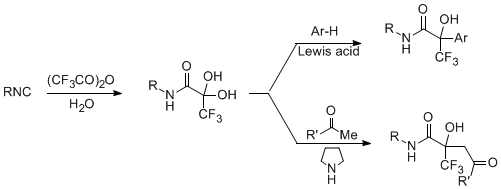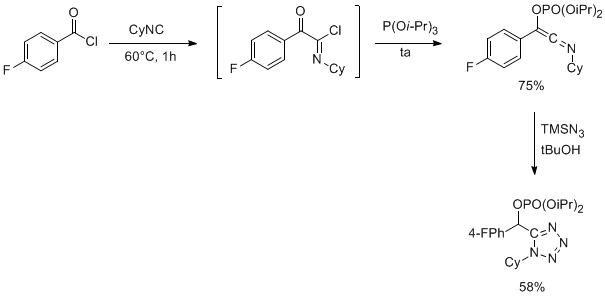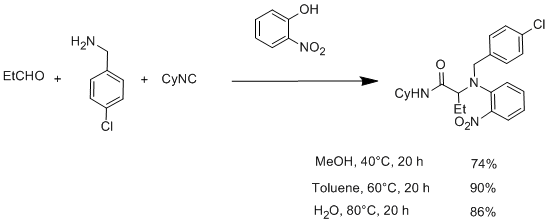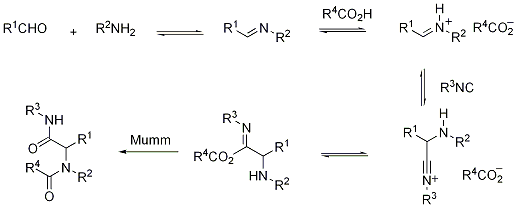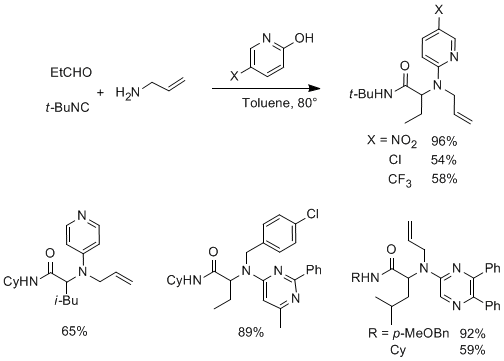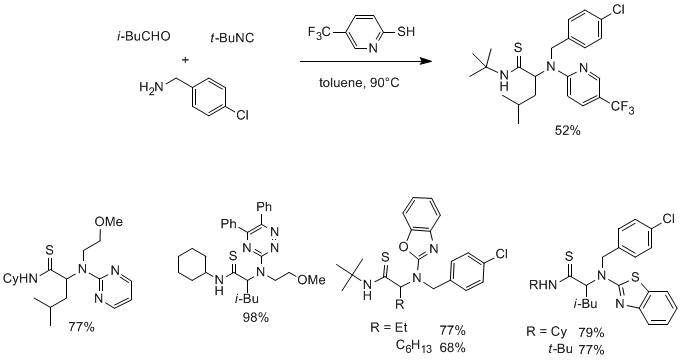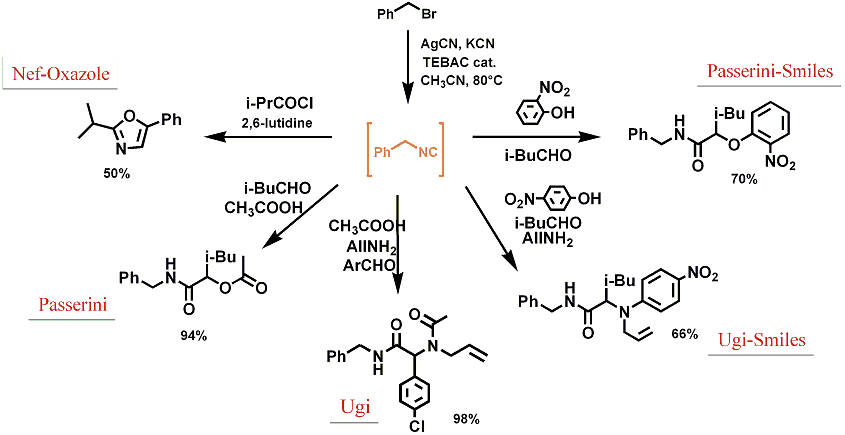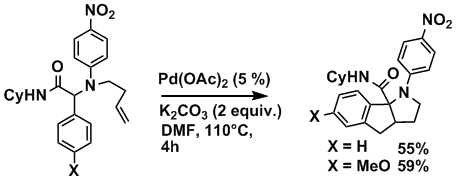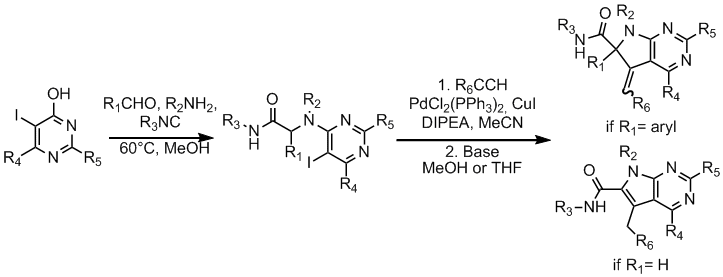

Nef-type reactions
Trifluoroacetic anhydride
Isocyanides addition to trifluoroacetic anhydride allows a straightforward preparation of trifluoropyruvamides derivatives. These compounds are useful fluorinated synthetic intermediates ; we have demonstrated that various nucleophiles are easily added on these stable hydrates.
Acyl chlorides
Nef-Huisgen
We have developed a new three-component triazole synthesis involving a Nef-Huisgen cascade. After the a-addition of acyl chlorides onto isocyanides (Nef reaction), the resulting imidoyl chloride is treated with tetrazoles under suitable activation (ZnCl2). The resulting adduct is unstable and evolves according to the Huisgen reaction.
Nef-Oxazoles
We have proposed an new oxazole synthesis which constitutes an alternative to the classical Van Leusen and Schöllkopf reaction. From the same starting materials, an isocyanide and an acyl chloride, , either 4,5-disubstituted oxazoles can be formed using strong base (Schöllkopf reaction) or 2,5-disusbtituted isomers using 2,6-lutidine. This constitutes a remarkable example of a base-induced chemoselective process in isocyanide chemistry.
Nef-Perkow
The addition of isocyanides to acyl chlorides (Nef reaction) leads to imidoyl chlorides which can later be treated with trialkylphosphites to afford new keteneimines in a Perkow-type reaction. The whole sequence may be performed without any solvent and the resulting keteneimine may easily be converted to phosphorylated tetrazoles and triazoles.
Ugi-type reactions
With Nitro derivatives
The use of nitro derivatives as potential electrophilic partner in coupling reactions with isocyanides was rather challenging. Isocyanide are moderatly nucleophilic and nitro compounds usually react as nucleophiles. Successfull coupling was made possible according a one-pot procedure mixing together the nitro derivative, the anhydride, the amine and the isocyanide. Mecanistic studies in relation with this work has allowed us to disclose a new conversion of nitro derivatives to nitrile.
Ugi-Smiles
In 2005, we have developed a new Ugi-type coupling using some electron-deficient phenols instead of the carboxylic acid.
This four-component coupling constitutes the first example of a Smiles rearrangement (SNAr) in a Ugi-type reaction. It allows a very straightforward access to N-aryl carboxamide derivatives. Best yields were observed with the highly activated ortho- and para-nitrophenols, salicylic derivatives giving adducts in lower yields. We are currently studying the mechanism of this coupling in collaboration with Dr Paul Fleurat-Lessard at the ENS Lyon (ANR-CP2D MUSE 2008).
We have also studied a three-component variant of this reaction coined as Passerini-Smiles reaction by coupling an aldehyde, an isocyanide and a nitro-phenol.The scope of these new reactions is further increased by the successful couplings of heterocyclic phenols such as hydroxypyridines and hydroxypyrimidines.
This study was extended to mercapto derivatives, and it affords a very straightforward multicomponent formation of N-arylamino thiocarboxamides. The scope of this new four-component coupling is further broadened with the use of heterocyclic mercapto derivatives that afford thioamides of high biological interest in one step.
More recently, we have developed some conditions to perform isocyanide-based multicomponent couplings without any manipulation of the isocyanides. Indeed, they are synthesized in situ from the corresponding alkyl bromide and directly coupled with the other partners of the reaction.
Ugi and Post-Condensation transformations
Radical chemistry
In collaboration with the Prof Luis Miranda (UNAM, Mexico), we developed various cascades involving xanthates in Ugi-coupling. We have shown that the best yields were obtained performing the Ugi reaction with chloro acetic acid and introducing the xanthate after the MCR. For instance, we have developed a convenient access to functionalized pyrrolidinones.
Other systems were explored as well to perform such MCR-radical cascades. Indeed, the use of the hydrazone derived from glyoxylic acid allow some thiophenol-induced cyclizations.
The use of malonic acid in Ugi couplings affords precursors oxidizable by Mn-salts. For example, such cascades provide a very interesting pathway towards cyclopropane containing polycyclic products.
Ugi-Pictet-Spingler
Using keto carboxylic acid as an Ugi acidic partner, we designed a MCR-Pictet Spengler cascade to obtain polycyclic systems in two steps.
Ugi-Sonogashira
Ugi reactions and [3+2] cycloaddition of pyridinium salts have been associated to provide an efficient multicomponent access to indolizines. The pyridinium salts are formed by an Ugi reaction using chloroacetic acid and propargylamine followed by pyridine addition on the Ugi adduct. The coupling of these salts with aryl iodides gives directly indolizine derivatives in a Sonoga-shira/cycloaddition/oxydation reaction cascade.
Ugi-Smiles and Post-Condensation transformations
Considering the usefulness of Ugi reactions in heterocyclic chemistry, we developed several cascades to synthesize heterocycles from Ugi-Smiles adducts. In order to be original, we decided to study mainly reactions involving the aromatic moiety. Various axes have been explored using the electron-withdrawing group already present onto the aromatic core or introducing additional functional groups -playing with the rich chemistry of phenols.
Cascades involving the nitro group
Hydrogenolysis of the nitro group of Ugi-Smiles adducts offers an interesting multicomponent synthesis of phenylenediamines. Using allylamine as a masked ammonia equivalent or directly ammonia, as we reported more recently, we designed an entry to benzotriazole and benzimidazole scaffolds.
Cascades involving metal salt-catalyzed processes
A new strategy involving Ugi-Smiles coupling followed by ring-closure metathesis was described for the preparation of pyrimidine fused heterocyclic scaffolds. This study presents a very efficient access to biologically relevant heterocyclic scaffolds.
The use of ortho-iodonitrophenol in Ugi-Smiles reaction coupled with Heck cyclization gives new access to indole scaffolds. The sequence can be performed in a one-pot reaction if the residual isocyanide is neutralized prior to the addition of the palladium catalyst.
Pursuing the studies concerning pallado-catalyzed processes, we have disclosed some new oxydative process with oxygen as the sole oxidant. The reactive intermediates form a-ketoamides or can undergo intramolecular cyclization to provide polycyclic derivatives in a palladium catalyzed cascade.
We have also reported a new route to highly substituted pyrrolo[2,3-d] pyrimidines featuring a Ugi-Smiles/Sonogashira cascade followed by an efficient base-catalyzed intramolecular cyclization.
Publications
- « A New conversion of Primary Nitro Compounds into Nitriles », L. El Kaïm, A. Gacon, Tetrahedron Letters, 1997, 38, 3391-3394.
- « Trifluoropyruvamides from Isocyanides and Trifluoroacetic Anhydride », L. El Kaïm, E. Pinot-Périgord, Tetrahedron, 1998, 54, 3799-3806.
- « A New Multicomponent Reaction of Nitro Compounds with isocyanides », Paul Dumestre, Laurent El Kaïm, Ariane Grégoire, Chem. Comm., 1999, 775-776.
- « Dramatic Solvent Effect in the Multicomponent Reaction of Nitro Compounds with Isocyanides », P. Dumestre, L. El Kaïm, Tetrahedron Letters, 1999, 7985-7986.
- « From isocyanides to trichloropyruvamides : Application to new preparation of Oxamide derivatives », L. El Kaïm, L. Gaultier, L. Grimaud, E. Vieu, Tetrathedron Lett, 2004, 45, 8047-8048.
- « New access to fluorinated ketoglycolic acid derivatives from trifluoropyruvamides », T. Colin, L. El Kaïm, L. Gaultier, L. Grimaud, L. Gatay, Tetrahedron Lett., 2004, 45, 5611-5613.
- « Phenol-Ugi-Smiles Systems: Highly efficient strategies for the multicomponent N-arylation of primary amines with isocyanides, aldehydes and phenols », L. El Kaïm, L. Grimaud, J. Oble, Angewandte Chem., Int. Ed, 2005, 44, 7165-7169.
- « Solvent free preparation of amidophosphonates from isocyanides », L. El Kaïm, L. Grimaud, S. Hadrot, Tetrahedron Letters, 2006, 47, 3945-3947.
- « New ortho-quinone methide formation: application to three-component coupling of isocyanides, aldehydes and phenols », L. El Kaïm L., Grimaud, J. Oble, Org. Biomol. Chem., 2006, 4, 3410 - 3413.
- « O-Arylative Passerini reaction », L. El Kaïm, M. Gizolme, L. Grimaud, Organic Letters, 2006, 8, 5021-5023.
- « Direct access to heterocyclic scaffolds by new multicomponent Ugi Smiles coupling », L. El Kaïm, M. Gizolme, L. Grimaud, J. Oble, Organic Letters, 2006, 8, 4019-4021.
- « Ugi/xanthate cyclisations as a radical route to lactam scaffolds », L. El Kaïm, L. Grimaud, L.D. Miranda, E. Vieu, Tetrahedron Letters, 2006, 47, 8259-8261.
- « New indolizines template from the Ugi reaction », L. El Kaïm, M. Gizolme, L. Grimaud, Synlett, 2007, 227-230.
- « New Ugi/Pictet-Spengler Multicomponent Formation of Polycyclic Diketopiperazines from Isocyanides and a-Keto Acids », L. El Kaïm, M. Gageat, L. Gaultier, L. Grimaud, Synlett, 2007, 500-502.
- « New Benzothiazole and Benzoxazole Scaffolds from the Ugi-Smiles Couplings of Heterocyclic Thiols », L. El Kaïm, M. Gizolme, L. Grimaud, J. Oble, Synlett, 2007, 465-469.
- « Smiles rearrangements in Ugi and Passerini type couplings : new multicomponent accesses to O- and N aryl amides », L. El Kaïm, M. Gizolme, L. Grimaud, J. Oble, J. Org. Chem, 2007, 72, 4169-4180.
- « New Ugi-Smiles-metathesis strategy towards the synthesis of pyrimido azepines », L. El Kaïm, M. Gizolme, L. Grimaud, J. Oble, J. Org. Chem., 2007, 72, 5835-5838.
- « Ugi-Smiles access to quinoxalines derivatives », J. Oble, L. El Kaïm, M. Gizzi, and L. Grimaud, Heterocycles, 2007, 73, 503-517.
- « From simple Ugi adducts to indanes and ?-amidomalonates : new manganese (III) induced radical cascades », L. El Kaïm, L. Grimaud, E. Vieu, Org. Lett., 2007, 9, 4171-4173.
- « New palladium-catalyzed aerobic oxidative cleavage and cyclization of N-aryl peptide derivatives », Laurent El Kaïm, Rocío Gámez-Montaño, Laurence Grimaud, Tannya Ibarra-Rivera, J. Chem. Soc., Chem. Commun. 2008, 1350-1352.
- « Isocyanide addition to acyl phosphonates: a formal Passerini reaction of acyl chlorides », Didier Coffinier, Laurent El Kaïm, Laurence Grimaud, Synlett. 2008, 1133-1136.
- « Ugi /Smiles access to pyrazine scaffolds », Anaëlle Barthelon, Aurélie Dos Santos, Laurent El Kaïm, Laurence Grimaud, Tet. Letters 2008, 49, 3208-3211.
- « New MCR-Heck-isomerization Cascade towards Indole », Laurent El Kaïm, Marion Gizzi, Laurence Grimaud, Org. Lett. 2008, 10, 3417-3419.
- « Thiols in Ugi- and Passerini-Smiles-type couplings », A. Barthelon, L. El Kaïm, M. Gizolme, L. Grimaud, European J. Org. Chem. 2008, 5974-5987.
- « New benzotriazole and benzimidazole scaffolds from Ugi-Smiles couplings of isocyanides », L. El Kaïm, L.; Grimaud, L.; Coffinier, D. Org. Lett. 2009, 11, 995-997.
- « Three component Ugi-Smiles couplings of cyclic imines », L. El Kaïm, L. Grimaud, L. Oble, J. Wagschal, S. Tetrahedron Lett. 2009, 50, 1741-1743.
- « Beyond the Ugi reaction : less conventional interactions between isocyanides and iminium species », L. El Kaïm, L. Grimaud, Tetrahedron 2009, 65, 2153-2171.
- « Three-component Nef/Huisgen access to 1,2,4-triazoles », L. El Kaïm, L. Grimaud, S. Wagschal, Synlett, 2009, 1315-1317.
- « IMCRs "without" isocyanides », L. El Kaï, L. Grimaud, A. Schiltz, Synlett 2009,1401-1404.
- « Isocyanide-based three-component keteneimine formation », D. Coffinier, L. El Kaïm, L. Grimaud, Org. Lett. 2009, 11, 1825-1827.
- « Ugi-Smiles Couplings : New Entries to N-Aryl Carboxamide Derivatives », Laurent El Kaïm, Laurence Grimaud, Mol. Div. 2009, accepted.
- « Unconventional oxazole formation from isocyanides », Aurélie dos Santos, Laurent El Kaïm, Laurence Grimaud, Caroline Ronsseray, Chem. Comm. 2009, 3907-3909.
- « "Isocyanide-free" Ugi reactions », Laurent El Kaïm, Laurence Grimaud, Aurélie Schiltz, Org. Biomol. Chem. 2009, 7, 3024.
- « One-pot synthesis of oxazoles using isocyanide surrogates », Laurent El Kaïm, Laurence Grimaud, Aurélie Schiltz, Tetrahedron Lett. 2009, 50, 5235-5237.
- « Four-component Synthesis of Imidazolinium-fused Heterocycles from Ugi-Smiles Couplings », Anaëlle Barthelon, Xavier-Frédéric Legoff, Laurent El Kaïm, Laurence Grimaud, Synlett, 2010, 153-157.
- « New xanthate-based radical cyclization onto alkynes », Laurent El Kaïm, Laurence Grimaud, Luis D. Miranda, Émilie Vieu, M.-Angeles Cano-Herrera and Karel Perez-Labrada, J. Chem. Soc., Chem. Commun. 2010.
- « 1,2,4-Triazole synthesis via amidrazones », Laurent El Kaïm, Marion Gizzi, Laurence Grimaud, Synlett 2010, 1771-1774.
- « Towards new pyrrolo[2,3-d]pyrimidines scaffolds », El Kaïm Laurent, Grimaud Laurence, Wagschal Simon, J. Org. Chem., 2010, 5343-5346.
- « Efficient Synthesis of Azaspirodienones by Microwave-Assisted Radical Spirocyclization of Xanthate-Containing Ugi Adducts », Gámez-Montaño Rocío, Ibarra-Rivera Tannya, El Kaïm Laurent, Miranda Luis D., Synthesis 2010; 1285-1290.
- « Ugi-Smiles couplings in water », Laurent El Kaïm, Laurence Grimaud, Srinivas R. Purumandla, Tetrahedron Lett. 2010, 4962-4964.
